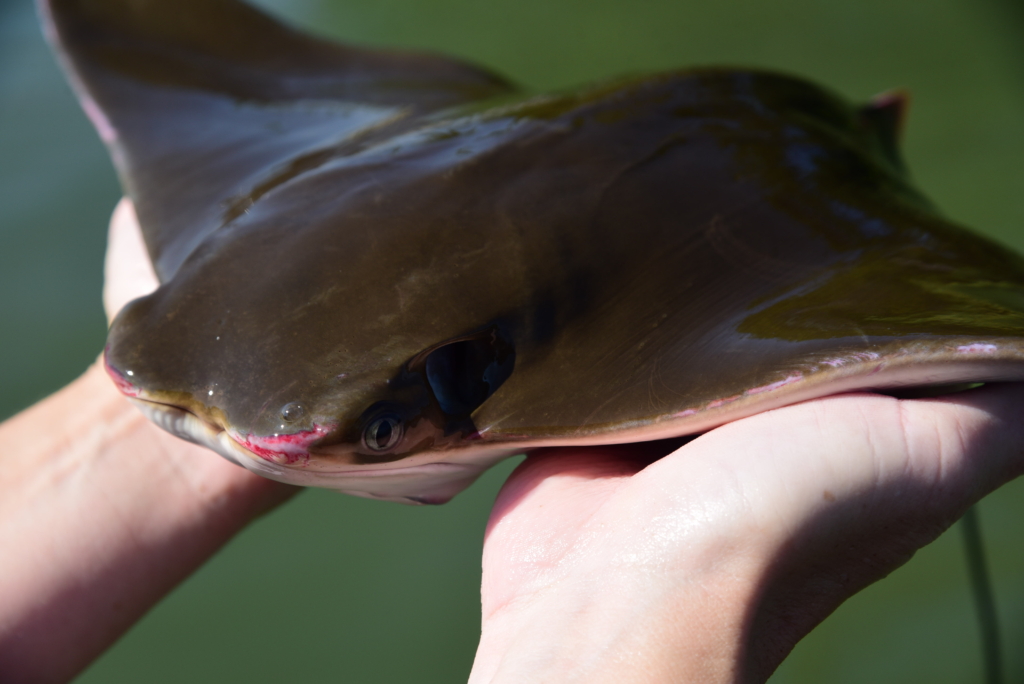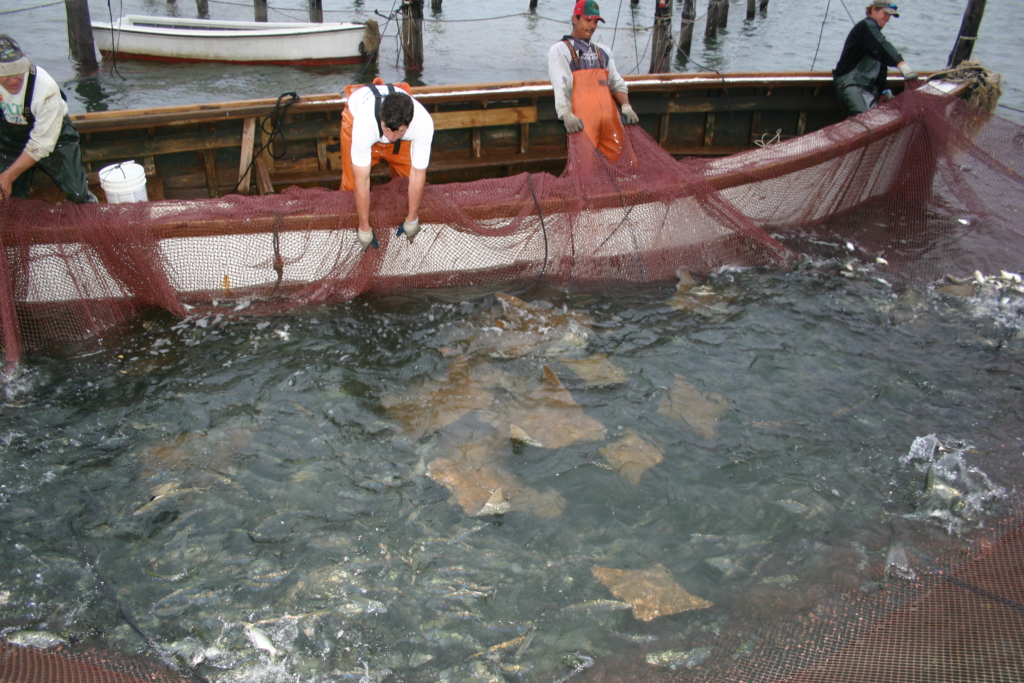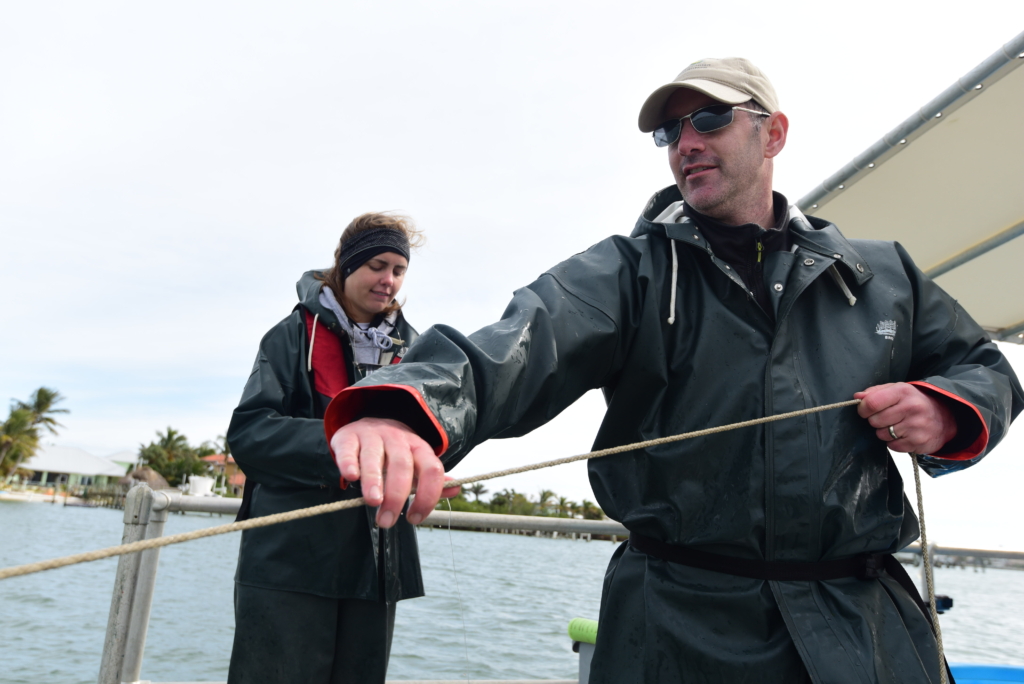Since 2014, a team of researchers at Smithsonian Environmental Research Center (SERC) has been tracking the migration of cownose rays. The rays are often spotted in the Chesapeake Bay in the summer, but until now nobody knew where the rays went for the winter. During a three-year tagging study published in August, Matt Ogburn and Charles Bangley tracked the rays all the way down the east coast and back for the first time.

Cownose rays are migratory animals that come into the Chesapeake in summer and swim to Florida for the winter. (Credit: Jay Fleming/SERC)
The team used acoustic tags that allow the researchers to track the rays for long time periods, and this resulted in “the first data that show the whole annual migration cycle in multiple years,” explained Ogburn.
The team tagged 42 rays by working with local watermen. Rays are often caught as bycatch in pound nets, a nuisance because of their stingers. Bay watermen were happy to partner with the researchers because they also wanted to learn more about this species. Many of the watermen already had long-standing relationships with Robert Fisher, a VIMS/Virginia Sea Grant scientist who has also studied the rays for three decades and who participated in the study.

Cownose rays are often caught as accidental bycatch in commercial pound nets like these. (Credit: Bob Fisher/VIMS)
For the SERC study, captured rays were put in a holding tank where researchers administered anesthesia before inserting the tags. Once the rays recovered, they were released back into the water. As the rays traveled down the east coast, the tags emitted “pings” unique to each ray that are received by lines placed by research institutions down the coast, sharing data on different species. The data was shared through the Atlantic Cooperative Telemetry Network and Florida Atlantic Coast Telemetry Network. Using this method, they were able to tag 42 rays, with 28 detected for longer than 90 days, providing strong migration data.
All of the rays overwintered off the coast of Cape Canaveral, Florida, and returned back to the Bay the following summer. Although only a few rays were tracked over both summers, the ones that were tracked came back to the same estuaries of the Bay where they were tagged. This could suggest that there is a Chesapeake-specific ray population. Previously, scientists thought that the rays could be a small part of a larger coastal population, but “the data from this paper suggests it’s more likely that the rays are coming back to the same place each year,” explained Ogburn. That means the population would be highly susceptible to disturbances like overfishing.

Scientists release a tagged cownose ray into the water. (Credit: Jay Fleming/SERC)
Cownose rays are K-selected species that reproduce and mature slowly. Each mature female typically produces only one offspring per year, so if the Chesapeake Bay population was wiped out by overfishing, the population would have a hard time recovering. The rays have been surrounded by controversy because it was thought that they were causing shellfish decline. Although rays do eat oysters, clams, and other shellfish, new research has shown that the mechanisms causing shellfish decline were well underway before scientists hypothesized that rays were to blame.
Scientists are now racing to learn more about how the rays fit in with the Chesapeake Bay ecosystem. Because the rays feed in soft-sediment habitats, and dig pits while digging for clams, researchers speculate that behavior could actually be beneficial to clams. Ogburn speculated, “is their activity of turning over the bottom important for the recruitment of new clams?”

SERC marine ecologist Matt Ogburn (front) and intern Claire Mueller search for bull sharks and cownose rays near Fort Pierce, Florida, in January 2018. (Credit: Jay Fleming/SERC)
In future studies, Ogburn wants to continue to track more rays and add genetic data to understand a bigger picture. First, rays leave the Bay as newborns and return once they’re 3-4 years old. The team wants to better understand where the rays go when they are 1-3 years old. In addition, Ogburn wants to understand the genetic variability of the rays. Although the telemetry (tracking) data suggests that the rays are coming back to the same places each year, population genetics could help understand the rays’ behavior on longer time scales.
A more thorough understanding of the life history of the rays could help make more informed recommendations to managers. The team wants to provide data that helps managers decide how and where ray fishing is done; “we want to make sure it’s done in a way that won’t crash the population,” explained Ogburn.
This research is a part of the new Movement of Life Initiative, a program of the Smithsonian Institution Conservation Commons that seeks “to advance the understanding of how all living things… move across changing land and seascapes to better sustain a biodiverse planet.”
